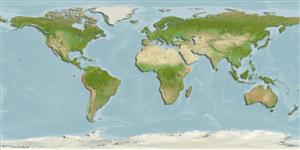Classification / Names
Common names | Synonyms | Catalog of Fishes(genus, species) | ITIS | CoL | WoRMS | Cloffa
Teleostei (teleosts) >
Ophidiiformes (Cusk eels) >
Bythitidae (Livebearing brotulas)
Etymology: Parasaccogaster: Name refers to the similarity to Saccogaster.
Eponymy: Dr Norma Victoria Chirichigno Fonseca (d: 1929) is a Peruvian ichthyologist who worked at the Instituto del Mar del Perú, Lima. [...] (Ref. 128868), visit book page.
More on authors: Cohen & Nielsen.
Environment: milieu / climate zone / depth range / distribution range
Ecology
Marine; demersal; depth range 80 - 150 m (Ref. 93007). Tropical
Southeast Pacific: off Peru to Costa Rica.
Size / Weight / Age
Maturity: Lm ? range ? - ? cm
Max length : 14.2 cm (female)
Dorsal soft rays (total): 83 - 87; Anal soft rays: 51 - 54; Vertebrae: 54 - 56. This species is distinguished from it congeners by the following characters: gill filaments on anterior arch is 4-5 times the length of the developed rakers; a pair of very small, subdermal, closely set spines on frontal plate above and behind eyes, absence of spine on ethmoid; anterior arch with 2-3 developed rakers, not much longer than spiny knobs; gill filaments on anterior arch 4-5 times length of developed rakers; palatines 2-4 tooth rows; prolonged pectoral peduncle adnate to body; vertebrae, precaudal 14-16 and total 54-56; fin rays, D 83-87, A 51-54, caudal 12-13, pectoral 17-19 (Ref. 93007).
Rare species, known from two specimens (Ref. 34024). A viviparous species living on the lower part of the continental shelf (80-150 m). Four examined female specimens are with well-developed eggs but apparently no embryos. Sections of ripe testes show that the spermatozoans are arranged in spermatophores (Ref. 93007).
Life cycle and mating behavior
Maturity | Reproduction | Spawning | Eggs | Fecundity | Larvae
Nielsen, J.G., W. Schwarzhans and D.M. Cohen, 2012. Revisions of Hastatobythites and Saccogaster (Teleostei, Bythitidae) with three new species and a new genus. Zootaxa 3579:1-36. (Ref. 93007)
IUCN Red List Status (Ref. 130435: Version 2024-1)
Threat to humans
Harmless
Human uses
Fisheries: of no interest
Tools
Special reports
Download XML
Internet sources
Estimates based on models
Preferred temperature (Ref.
123201): 11.5 - 15.7, mean 14.7 °C (based on 22 cells).
Phylogenetic diversity index (Ref.
82804): PD
50 = 0.6250 [Uniqueness, from 0.5 = low to 2.0 = high].
Bayesian length-weight: a=0.00447 (0.00172 - 0.01163), b=3.10 (2.87 - 3.33), in cm total length, based on LWR estimates for this (Sub)family-body shape (Ref.
93245).
Trophic level (Ref.
69278): 3.3 ±0.5 se; based on size and trophs of closest relatives
Resilience (Ref.
120179): High, minimum population doubling time less than 15 months (Preliminary K or Fecundity.).
Fishing Vulnerability (Ref.
59153): Low vulnerability (10 of 100).
